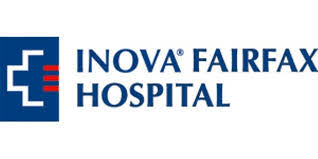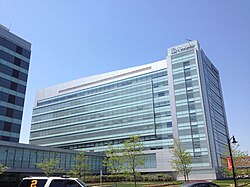
Stanford University Medical Center is a teaching hospital which includes Stanford Health Care and Stanford Children's Health. It serves as a private hospital for the Stanford University School of Medicine. In 2022–23, it was ranked by the US News as the 3rd-best hospital in California and 10th-best in the country.

The University of Texas Southwestern Medical Center is a public academic health science center in Dallas, Texas. With approximately 23,000 employees, more than 3,000 full-time faculty, and nearly 4 million outpatient visits per year, UT Southwestern is the largest medical school in the University of Texas System and the State of Texas.

The University of Texas MD Anderson Cancer Center is a comprehensive cancer center in Houston, Texas. It is the largest cancer center in the world and one of the original three NCI-designated comprehensive cancer centers in the country. It is both a degree-granting academic institution and a cancer treatment and research center located within the Texas Medical Center, the largest medical center and life sciences destination in the world. MD Anderson Cancer Center has consistently ranked #1 among the best hospitals for cancer care and research in the U.S. and worldwide, and it has held the #1 position 20 times in the last 23 years in U.S. News & World Report's Best Hospitals rankings for cancer care. As of 2023, MD Anderson Cancer Center is home to the highest number of cancer clinical trials in the world and has received more NCI-funded projects than any other U.S. institute. For 2024, Newsweek placed MD Anderson at #1 in their annual list of the World's Best Specialized Hospitals in oncology.

Dartmouth–Hitchcock Medical Center (DHMC), the flagship campus of the Dartmouth Health system, is the U.S. state of New Hampshire's only academic medical center. DHMC is a 507-inpatient bed hospital and serves as a major tertiary-care referral site for patients throughout northern New England. As an academic medical center, DHMC offers primary, specialty and subspecialty care as well as education and research in partnership with the Geisel School of Medicine at Dartmouth, one of America's oldest medical schools, as well as the Thayer School of Engineering at Dartmouth and The Dartmouth Institute for Health Policy & Clinical Practice.

MaineHealth Maine Medical Center Portland (MMCP), commonly contracted to Maine Med, is a 700-licensed-bed teaching hospital in Portland, Maine, United States. Affiliated with Tufts University School of Medicine, it is located in the Western Promenade neighborhood. It has a staff of over 9,500. The facility is one of only three Level I Trauma Centers in Northern New England. Founded in 1874, it is the largest hospital in northern New England with 28,000 inpatient visits, about 500,000 outpatient visits, 88,000 emergency visits, and over 27,000 surgeries performed annually. MMCP is structured as a non-profit, private corporation governed by volunteer trustees. Maine Medical Center Portland is wholly owned by, and serves as the flagship hospital for MaineHealth, a non-profit healthcare network servicing Maine and New Hampshire.
UC San Diego Health is the academic health system of the University of California, San Diego in San Diego, California. It is the only academic health system serving San Diego and has one of three adult Level I trauma centers in the region. In operation since 1966, it comprises three major hospitals: UC San Diego Medical Center in Hillcrest, Jacobs Medical Center in La Jolla, and East Campus Medical Center at UC San Diego Health in East County. The La Jolla campus also includes the Moores Cancer Center, Shiley Eye Institute, Sulpizio Cardiovascular Center, and Koman Family Outpatient Pavilion, and the health system also includes several outpatient sites located throughout San Diego County. UC San Diego Health works closely with the university's School of Medicine and Skaggs School of Pharmacy to provide training to medical and pharmacy students and advanced clinical care to patients.

Inova Fairfax Medical Campus is the largest hospital campus in Northern Virginia and the flagship hospital of Inova Health System. Located in Woodburn in Fairfax County, Virginia, Inova Fairfax Hospital is one of the largest employers in the county. Inova Fairfax Hospital is also home to a neonatal intensive care unit, and a dedicated pediatrics intensive care unit, an oncology unit, an adolescent medicine unit, and centers for cardiac surgery and pediatric surgery.

The Rutgers Cancer Institute of New Jersey (CINJ) is a cancer treatment and research institution that is a part of Rutgers University and located in New Brunswick, New Jersey. CINJ is one of only 56 Comprehensive Cancer Centers in the nation designated by the National Cancer Institute and the only one in New Jersey located in the heart of New Brunswick.

Stamford Hospital, residing on the Bennett Medical Center campus, is a 305-bed, not-for-profit hospital and the central facility for Stamford Health. The hospital is regional healthcare facility for Fairfield and Westchester counties, and is the only hospital in the city of Stamford, Connecticut.

Hackensack University Medical Center (HUMC) is a 950-bed non-profit, research and teaching hospital providing tertiary and healthcare needs located seven miles (11 km) west of New York City, in Hackensack, Bergen County, New Jersey, United States. As of 2019, it ranks as the second-largest hospital in New Jersey and No. 59 in the US. HUMC is the largest hospital in the Hackensack Meridian Health Health System. It is affiliated with the New Jersey Medical School of Rutgers University and Hackensack Meridian School of Medicine. The medical center was founded in 1888 as Bergen County's first hospital, with 12 beds. The hospital is an ACS verified level 1 trauma center, one of five in the state. In 2021 it was given a grade A by the Leapfrog patient safety organization.

Rhode Island Hospital is a private, not-for-profit hospital located in the Upper South Providence neighborhood in Providence, Rhode Island. It is the largest academic medical center in the region, affiliated with Brown University since 1959. As an acute care teaching hospital, Rhode Island Hospital is the principal provider of specialty care in the region and the only Level I Trauma Center in southeastern New England. The hospital provides a full range of diagnostic and therapeutic services to patients, with particular expertise in cardiology, including the state's only open heart surgery program; diabetes, emergency medical and trauma, neurosciences, oncology/radiation oncology, orthopedics, pediatrics, and surgery. Rhode Island Hospital's pediatrics division, Hasbro Children's Hospital, is the only pediatric facility in the state. Recording nearly 154,000 visits in the fiscal year of 2016, Rhode Island Hospital's adult and pediatric emergency wings are among the busiest in the United States.

University of Missouri Health Care is an American academic health system located in Columbia, Missouri. It's owned by the University of Missouri System. University of Missouri Health System includes five hospitals: University Hospital, Ellis Fischel Cancer Center, Missouri Orthopedic Institute and University of Missouri Women's and Children's Hospital — all of which are located in Columbia. It's affiliated with Capital Region Medical Center in Jefferson City, Missouri. It also includes more than 60 primary and specialty-care clinics and the University Physicians medical group.
Spartanburg Regional Healthcare System(SRHS) is one of South Carolina's largest healthcare systems. SRHS draws patients primarily from the areas of Spartanburg, Cherokee, Union, and Greenville counties (all located in the Piedmont region of South Carolina), as well as Polk county (located in western North Carolina). Spartanburg General Hospital was organized under the authority of the South Carolina General Assembly in 1917. It officially became the Spartanburg Regional Health Services District, Inc., a political subdivision of the State of South Carolina, by the charter granted by the Secretary of State of South Carolina on May 1, 1995.

MedStar Washington Hospital Center is the largest private hospital in Washington, D.C. A member of MedStar Health, the not-for-profit Hospital Center is licensed for 926 beds. Health services in primary, secondary and tertiary care are offered to adult and neonatal patients. It also serves as a teaching hospital for Georgetown University School of Medicine.
Banner Health is a non-profit health system in the United States, based in Phoenix, Arizona. It operates 33 hospitals and several specialized facilities across 6 states. The health system is the largest employer in Arizona and one of the largest in the United States with over 55,000 employees.

Baptist Health (Jacksonville) is a faith-based, non-profit health system comprising 6 hospitals with 1,168 beds, a cancer center, four satellite emergency departments and more than 200 patient access points of care, including 50 primary care offices located throughout northeast Florida and southeast Georgia. The headquarter is in Jacksonville, Florida.

The Valley Hospital is a 370-bed, acute-care, not-for-profit hospital in Paramus, New Jersey, United States, in the heart of Bergen County. Valley staff includes more than 1,100 physicians, 3,700 employees, and 3,000 volunteers. In 2020, Valley recorded 41,345 admissions, 51,792 emergency department visits, and 3,528 births.

St. Luke's University Health Network (SLUHN) is a non-profit network of 15 campuses and over 300 outpatient sites. The health network is headquartered in Bethlehem, Pennsylvania.
Sutter Medical Center, Sacramento (SMCS) is a medical center in Sacramento, California, that has been named one of the Top 100 Hospitals in the US for five years, including 2013–2015. It is owned and operated by Sutter Health, a Northern California not-for-profit health system. The center offers both community-based and tertiary medical services. In 2015, the center consolidated its Sutter Memorial Hospital campus in East Sacramento with its midtown Sutter General Hospital location, with the opening of the Anderson Lucchetti Women's and Children's Center and the complete remodeling of Sutter General Hospital into the Ose Adams Medical Pavilion. The midtown location is where Sutter Health's first hospital, Sutter Hospital, opened in 1923. The center also includes Sutter Center for Psychiatry, providing psychiatric, mental health and chemical dependency services since 1958.

The University of Florida College of Medicine – Jacksonville is the largest of the three University of Florida Health Science Center Jacksonville colleges — medicine, nursing and pharmacy. The college's 16 clinical science departments house more than 440 faculty members and 380 residents and fellows. The college offers 34 accredited graduate medical education programs and 10 non-standard programs.






















